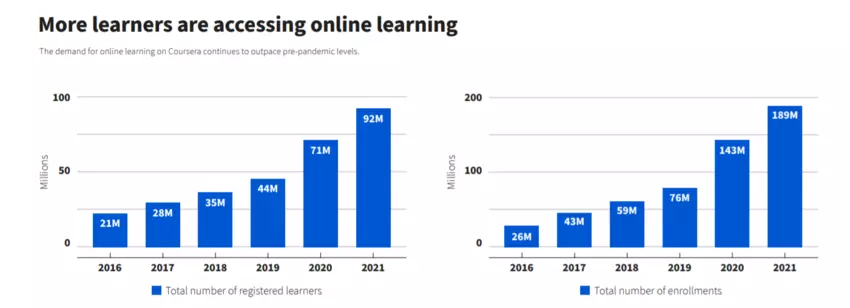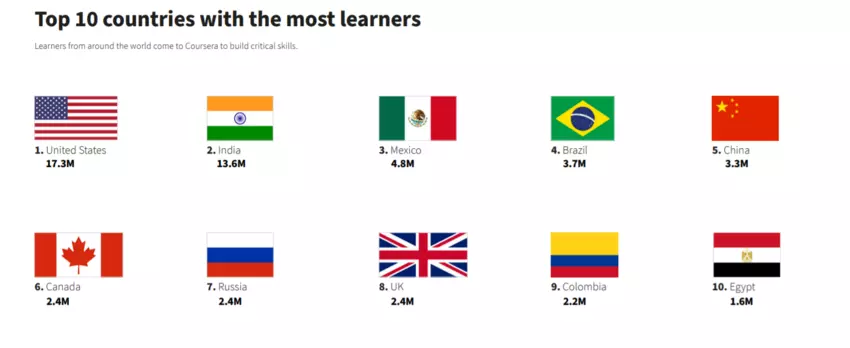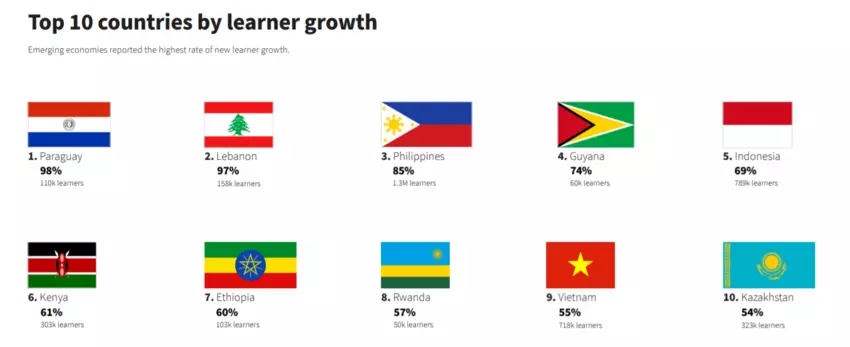In this article, I shared “3 Graphs Showing The Global Expansion Of Online Learning.”
Learn more by reading on.
People are increasingly turning to online courses to help them navigate today’s fast-changing job market.
Coursera is an online education platform that will have signed up 20 million new students by the year 2021.
In emerging economies, the number of new online learners grew the fastest. Online education is needed because the world’s skills gap is growing.
A well-known global online learning platform says that the number of students taking online classes is now higher than before the pandemic.
As a result of the trend toward remote work caused by COVID-19, more and more people are turning to digital learning to get the skills they need to succeed in the constantly changing world of work today.
Coursera’s 2021 Impact Report says that more than 20 million new students signed up for courses that year.
This is the same amount of growth that happened in the three years before the pandemic.
The rise is part of a longer trend that started before the outbreak and is getting stronger now.
What is the best LMS platform to invest in? You can learn more about it in this review
3 Graphs Depicting The Global Expansion Of Online Learning In 2024
1. The Upward Trend In Online Learning
In 2016, 21 million people signed up for online courses through Coursera. This is an increase of about 7 million per year for the next two years.
When the pandemic hit, however, the switch to remote work caused the number of new registrations to triple, bringing the total to 71 million in 2020 and 92 million in 2021.
Online course enrollment followed a similar pattern, with improvements before the pandemic being overshadowed by huge increases.
In 2020, the number of people going to school more than tripled. The next year, it went up by 32%, reaching a high of 189 million.
These increases show that online education is becoming more popular around the world.
More people are enrolling in college from far away, especially those from underserved or rural areas.
Source: Coursera
2. Where Do Most People Who Learn Online Live?
The Asia-Pacific region has the most students on the learning platform, with 28 million new online learners signing up for 68 million courses.
Europe, North America, and Latin America are next in terms of the number of students using the platform.
Source: Coursera
Compared to that, only 3 million African students signed up for 5 million online courses.
On the other hand, both the number of students who signed up for courses and the number of students who signed up as students went up the most in Africa. (up 50 percent).
Source: Coursera
On a national level, the United States came in first with more than 17 million people signed up for online learning.
India came in second with 13.6 million people. Between these two countries and Mexico, there were more than 5 million people.
Brazil and China made up the rest of the top five.
On the other hand, the number of new learners grew the most in emerging economies, with Paraguay leading the way with a 98 percent rise to 110,000 students.
Lebanon’s student population grew by 97 percent, to 158,000. Even though there were 85 percent more students, there were still only 1.3 million students in the Philippines as a whole.
There are a lot of students in developing countries like Indonesia, Vietnam, Kenya, and Kazakhstan, and that number is expected to grow by more than 50% by 2021.
3. Developing Future Skills
Access to high-quality online learning is a key way to help people make sure their skills are useful in the future and find new ways to grow and develop.
The epidemic has sped up a world that was already changing quickly. Artificial intelligence (AI) and automation are still upsetting job markets and making big changes. Because of this, the futures of many people are uncertain.
According to the Forum’s The Future of Jobs Report 2020, the rate of technological progress is expected to stay the same or speed up in many fields.
Several advances in nonhumanoid robots, digital encryption, and AI (artificial intelligence) are anticipated to continue to dominate major corporations in the years ahead.
A lot of people think that the future of work is already here.
Also, even though the number of “jobs of the future” created by the technological revolution will be more than the number of jobs lost, the immediate effects may force many people out of work and leave them without the skills they need to do new, more technical jobs.
As well as creating new opportunities, disruption also requires new skills.
People and companies are putting more emphasis on learning new skills, which could offer solutions.
Sixty-six percent of the employers interviewed for the report think that their investment in upskilling and reskilling workers will pay off within a year.
There are now five times as many employers offering online learning opportunities to their employees, four times as many people looking for online learning opportunities on their own, and nine times as many government-sponsored online learning opportunities.
By 2030, the World Economic Forum’s Reskilling Revolution is aimed at improving the education, work skills, and employment opportunities for one billion people.
Get a Huge Discount On the greatest LMS platform
FAQs
Why are people turning to online courses?
People are choosing online courses to adapt to the fast-changing job market and acquire new skills, especially in response to the shift toward remote work caused by the COVID-19 pandemic.
Which regions have the most online learners?
The Asia-Pacific region has the most online learners, followed by Europe, North America, and Latin America. Emerging economies, particularly in Africa, saw the fastest growth in new learners.
Which countries have the highest number of online students?
The United States leads with over 17 million online students, followed by India with 13.6 million. Other top countries include Mexico, Brazil, and China.
What impact did the pandemic have on online learning?
The pandemic significantly boosted online course enrollments, with many more people turning to digital platforms to gain new skills as remote work became widespread.
Why is online learning important for future skills?
Online learning is crucial for acquiring future skills, especially as technological advancements like AI and automation reshape job markets. It helps individuals stay relevant and adapt to new job requirements.
How are employers responding to the need for new skills?
Many employers are investing in upskilling and reskilling their employees, offering more online learning opportunities and supporting continuous education.
Quick Links:
- How Online Learning Is Reshaping Higher Education?
- How Online Learning Affects Mental And Physical Health?
- Top 5 Online Learning Strategies for Students
Conclusion: The Global Expansion Of Online Learning In 2024
The global expansion of online learning has been rapid, particularly accelerated by the COVID-19 pandemic.
With platforms like Coursera leading the way, millions of new learners from diverse regions are engaging in digital education to gain critical skills.
This trend reflects the growing importance of online learning in bridging skills gaps and preparing individuals for a technology-driven future.
As the demand for flexible and accessible education continues to rise, online platforms are becoming essential tools for personal and professional growth.




